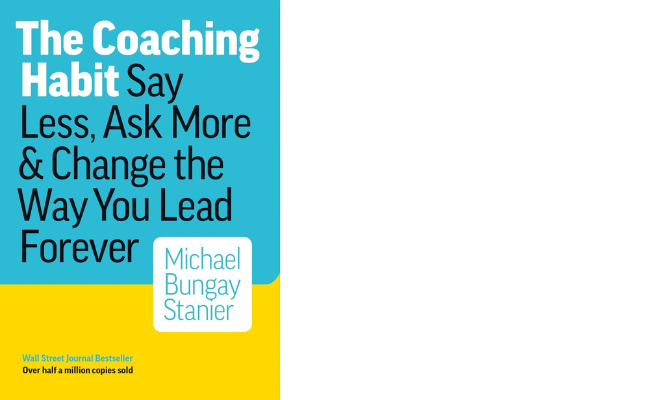The Coaching Habit: How to Empower Your Team Through Informal Conversations

In today’s fast-paced business environment, most business managers find themselves caught in the whirlwind of urgent tasks, deadlines, and performance pressures. They often overlook the transformative power of coaching in unlocking the full potential of their teams. However, the rise of “the coaching habit” presents a fresh innovative take on this scenario.
This habit, popularized by expert coach Michael Bungay Stanier, fosters everyday coaching skills within leaders, promoting better employee engagement, communication, and productivity. At the heart of the coaching habit lies the strategic use of seven coaching questions, revolutionizing the way you lead forever.
This article unfolds the concept of the coaching habit and its implications on team dynamics, offering a practical, habit-forming leadership manual to the readers.
A Deep Dive into the Coaching Habit
To truly understand the transformative power of the coaching habit, we need to take a closer look at its core components. This section will delve into the principles of the coaching habit and how they relate to team performance and engagement.
We will explore why the coaching habit isn’t just a method or habit-forming leadership manual but a mindset that shapes meaningful interactions and empowers teams to reach their full potential.
Image credits: Amazon
Grasping the Essentials of the Coaching Habit
The coaching habit is more than a set of techniques. It represents a transformational shift in leadership styles, where business managers engage in frequent, short conversations with their team members. Contrary to a traditional how-to manual, the coaching habit is about asking the right questions rather than giving advice.
A coaching session, guided by seven powerful questions, brings clarity, encourages learning, and fosters a solution-oriented mindset. Michael Bungay Stanier’s book combines insider information with practical wisdom, rendering it a valuable coaching toolbox for any leader. The application of the coaching habit has a profound impact on team performance, leading to more engaged, self-sufficient, and resilient teams.
The coaching habit takes root in real conversation, fostering a culture where team members feel heard, valued, and motivated. By cultivating everyday habits around active listening and purposeful questioning, leaders can transform their interactions into effective coaching opportunities.
You may also like: Leadership vs. Management: What’s the Big Deal?
The Seven Essential Coaching Questions
These seven coaching questions form the backbone of the coaching habit. They’re not your typical conversation starters but powerful interactive training tools designed to trigger deeper thinking, encourage self-reflection, and foster problem-solving.
This section is your guide to understanding and leveraging these seven questions, complete with practical examples and case studies to demonstrate their application.
Question 1: What’s on Your Mind?
The “Kickstart Question” (“What’s on your mind?”) is a brilliant conversation opener. This coaching question invites the person dealing with an interpersonal or external challenge to share their thoughts and feelings.
This initial question sets the stage for a meaningful coaching session. You subtly nudge the person to reflect and articulate their concerns, promoting self-awareness and empowering them to take control of the situation.
As a leader, when you practice this question, you encourage a culture of open communication, where team members feel comfortable sharing their concerns and ideas. It signals that you value their input and are willing to listen, fostering a strong sense of belonging and trust among the team.
This approach not only enhances employee engagement but also provides you with valuable insights into team dynamics and potential areas of improvement.
Question 2: And What Else?
The “AWE Question” (“And what else?”) is a powerful tool that encourages deeper exploration of issues. As an everyday coaching skill, it helps you resist the “Advice Monster,” prompting the person to consider alternative perspectives or solutions. This question helps in identifying underlying concerns or opportunities that may not be apparent at first glance.
For instance, suppose a team member approaches you with a challenging project. Instead of jumping to solutions, you can ask, “And what else?” This question prompts them to think deeper about the issue, possibly uncovering underlying factors or alternative approaches.
Fostering this habit nurtures a culture of critical thinking and problem-solving within your team. Forward, critical thinking paves the way for innovative solutions and continuous improvement in your organization.
Question 3: What’s the Real Challenge Here for You?
The “Focus Question” (“What’s the real challenge here for you?”) helps in getting to the heart of the issue. It encourages the person to sift through various surface-level problems and identify the core issue that needs addressing. This question fosters self-reflection and promotes a new habit of a solution-oriented mindset.
Consider a scenario where a team member is overwhelmed with multiple tasks. Asking, “What’s the real challenge here for you?” guides them to identify the underlying issue. Perhaps it’s time management, unclear priorities, or lack of delegation. Once you identify the real challenge, it’s easier to brainstorm effective strategies to overcome it.
Practicing this question regularly can significantly enhance team performance. In a sense, you help your team recognize and address the root causes of challenges, leading to more sustainable solutions.
Question 4: What Do You (Really) Want (from Me)?
The “Foundation Question” (“What do you [really] want [from me]?”) is about clarifying desired outcomes and aligning individual and team goals. This question helps in creating shared understanding and expectations, fostering better collaboration and mutual support.
Imagine a situation where a team member constantly asks for your help, affecting your own productivity. Instead of giving advice, you can ask, “What do you (really) want (from me)?”
This might sound too on the nose but will lead them to articulate their exact needs, allowing you to better support them without compromising your own work. Over time, this practice can enhance team performance as everyone understands their roles and expectations better.
Question 5: How Can I Help?
The “Lazy Question” (“How can I help?”) plays a significant role in nurturing a culture of support and collaboration. It encourages the person to take ownership of their problem and define the type of assistance they need, thereby promoting responsibility and problem-solving skills.
This question is extremely powerful in situations where you are tempted to jump in and solve problems for your team. Instead, by asking “How can I help?” you place the responsibility back on them, prompting them to think through their issue and articulate how exactly they need your assistance.
This practice empowers your team members, making them more self-sufficient and confident in handling challenges, which in turn leads to better team performance.
Question 6: If You’re Saying Yes to This, What Are You Saying No To?
The “Strategic Question” (“If you’re saying yes to this, what are you saying no to?”) is a reminder of the commitments and trade-offs involved in every decision. It promotes effective decision-making and prioritization skills, essential components of a high-performing team.
You can use this question effectively when a team member is overwhelmed with multiple tasks. Asking “If you’re saying yes to this, what are you saying no to?” encourages them to consider the trade-offs and make conscious decisions about their priorities.
Regularly incorporating this question into your interactions can lead to better time management and productivity within your team, encouraging thoughtful decision-making and effective prioritization.
Question 7: What Was Most Useful or Valuable Here for You?
The “Learning Question” (“What was most useful or valuable here for you?”) reinforces learning and positive behaviors. It drives continuous improvement, a crucial aspect of maintaining high team performance.
This question is particularly useful at the end of coaching sessions or project discussions. It helps team members reflect on their learning and identify the most valuable aspects of the conversation. This practice enhances the learning experience and encourages the application of these insights in future tasks.
For instance, after a brainstorming session, asking “What was most useful or valuable here for you?” will help your team members crystallize their takeaways, making the session more impactful. Asking this question regularly can foster a culture of learning and improvement within your team, enhancing its overall productivity and performance.
Harnessing the Power of Informal Conversations
Contrary to the traditional perception of coaching as a formal, structured process, the coaching habit embraces the potential of informal conversations. This section will uncover the magic of spontaneous, authentic dialogues and their role in fostering a coaching culture.
Let’s dig deeper into the art of initiating and nurturing informal conversations and how they can become powerful channels for coaching and feedback.
Decoding Informal Conversations
Informal conversations, as opposed to formal coaching sessions, offer a more relaxed and authentic platform for interaction. These casual chats can often reveal valuable insights into team dynamics, individual concerns, and hidden opportunities.
Active listening plays a vital role in these conversations. As a leader, your ability to listen, empathize, and respond appropriately can significantly influence the outcomes of these interactions.
Whether it’s a quick catch-up at the water cooler or a chat over coffee, these conversations can serve as effective coaching tools, promoting open dialogue, building trust, and encouraging mutual respect.
The power of informal conversations lies in their spontaneity and authenticity. They allow you to understand your team better, build stronger relationships, and make your team members feel valued and heard.
Advantages and Barriers of Informal Conversations
Informal conversations, when utilized effectively, can break down barriers, foster a sense of belonging, and enhance team engagement. They provide a safe space for employees to share their ideas, challenges, and aspirations, leading to increased trust and collaboration.
However, initiating and maintaining these conversations can be challenging for some leaders. Common barriers include time constraints, discomfort with casual interactions, or uncertainty about crossing professional boundaries.
Overcoming these challenges requires a deliberate effort. It involves creating a culture that encourages open communication, making time for informal interactions, and developing interpersonal skills. Remember, it’s not about forcing conversations but about creating an environment where they can naturally occur.
Implementing and Evaluating the Coaching Habit
Implementing the coaching habit in the workplace involves creating a supportive environment, training leaders in coaching techniques, and encouraging regular practice. This process should suit the unique needs of your team and organization.
Start by sharing the concept of the coaching habit and its benefits with your team. Provide training on the seven coaching questions and how to use them effectively. Encourage your team to practice these questions in their day-to-day interactions and coaching sessions.
Successful implementation requires patience, consistency, and a willingness to learn and adapt. Watch out for common pitfalls like reverting to giving advice or ignoring the power of informal conversations. Remember, developing a new habit takes time and practice, but the payoff in terms of enhanced team performance and engagement is worth the effort.
You may also like: How Situational Leadership Can Help You Build a Stronger Team
Gauging Success: Measuring the Impact of the Coaching Habit
Measuring the impact of the coaching habit is critical to truly understanding its effectiveness in your organization. The assessment should be multi-faceted, examining how the coaching habit has affected individual performance, team dynamics, and overall organizational culture.
Here’s how you can systematically measure the impact of your coaching habit:
Assessing Individual Performance
Evaluating the coaching habit’s impact starts at the individual level. Are your team members more engaged, motivated, and productive? You can assess these aspects through performance reviews, feedback surveys, and direct observation.
Look for improvements in task completion, goal achievement, and overall work quality. Remember, the coaching habit aims to empower individuals to find their solutions, so an increase in proactive behavior is a good indicator of success.
Examining Team Dynamics
The coaching habit’s influence goes beyond individuals and can dramatically reshape team dynamics. Teams should become more cohesive, collaborative, and resilient.
You can measure these aspects by observing team interactions, assessing the quality of team outputs, and getting feedback from team members. Watch for signs of improved communication, conflict resolution, and collective problem-solving.
Analyzing Organizational Culture
This coaching mantra can significantly transform the overall organizational culture, fostering an environment of trust, continuous learning, and mutual support. To gauge this, look at the average rating of employee engagement and satisfaction scores, attrition rates, and overall morale.
Conduct culture surveys to assess employees’ perceptions and feelings about the workplace. You can also use anonymous suggestion boxes or feedback platforms for candid insights.
Refining the Coaching Approach
Evaluation should be followed by action. Use your assessment insights to refine your coaching methods and address any gaps. This might involve further training, modifying the coaching questions, or investing more in informal conversations.
Remember, the journey to instilling a coaching habit is a continuous process of learning and improvement. Stay flexible, stay curious, and stay committed to creating a thriving coaching culture.
Final Thoughts
The coaching habit is more than a set of questions or a leadership style. It’s a transformative approach to leading, managing, and interacting with your team. Asking powerful questions and fostering open, authentic conversations help build stronger relationships, inspire continuous learning, and create a thriving workplace culture.
As you embark on your journey to cultivate the coaching habit, remember the words of Michael Bungay Stanier: “Stay curious. Stay genuine. Stay courageous.” It’s about daring greatly, changing your own habits, and empowering those around you. The coaching habit could be your key to unlocking higher levels of team engagement and performance, making a real and lasting impact.
For further reading and support, we recommend exploring Michael Bungay Stanier’s other works, as well as resources from expert coaches and leadership gurus. The journey may be challenging, but it can change the way you lead forever.







